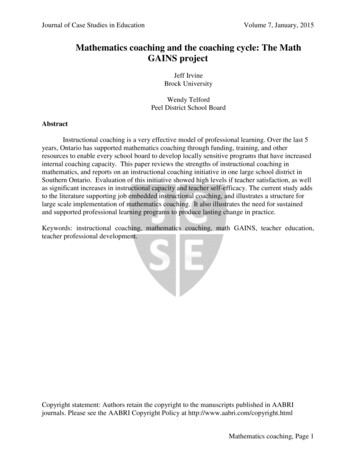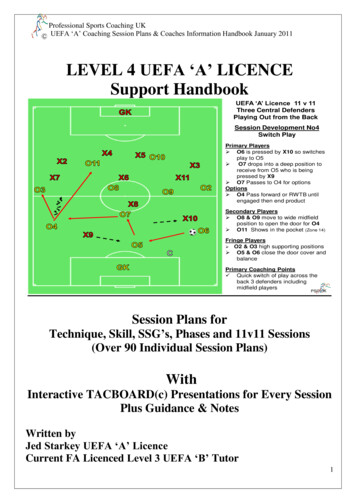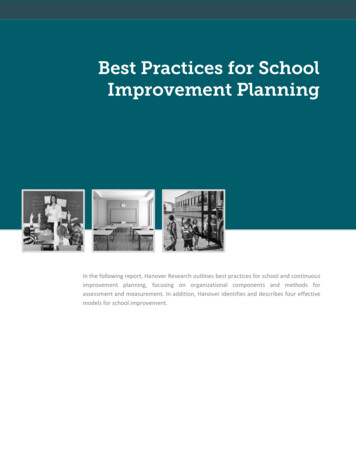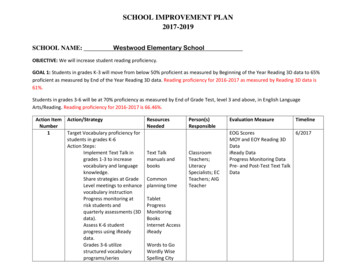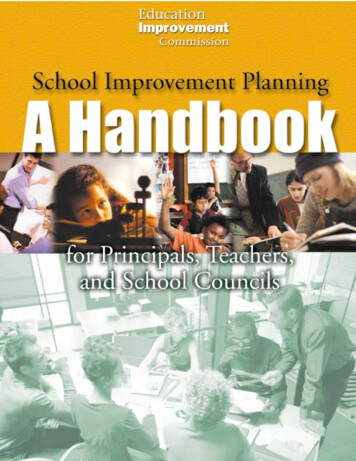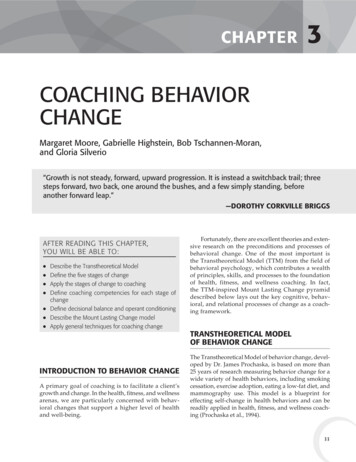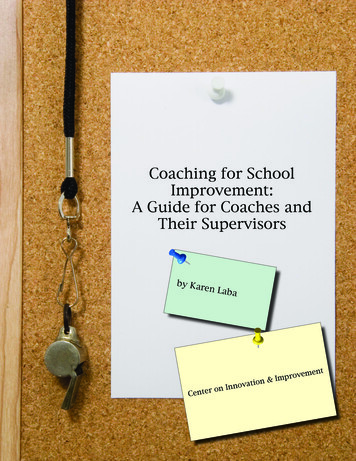
Transcription
Coaching for SchoolImprovement:A Guide for Coaches andTheir Supervisorsby Karen Labatvemenr onCentero& ImpnoitaInnov
Center on Innovation & Improvement121 N. Kickapoo StreetLincoln, IL ive results for students will come from changes in the knowledge, skill, and behavior of their teachers andparents. State policies and programs must provide the opportunity, support, incentive, and expectation for adults closeto the lives of children to make wise decisions.The Center on Innovation & Improvement helps regional comprehensive centers in their work with states to providedistricts, schools, and families with the opportunity, information, and skills to make wise decisions on behalf ofstudents.The Center on Innovation & Improvement is administered by the Academic Development Institute (Lincoln, IL) inpartnership with the Temple University Institute for Schools and Society (Philadelphia, PA) and Little Planet Learning(Nashville, TN).A national content center supported by theU. S. Department of Education’s Office of Elementary and Secondary Education.Award #S283B050057The opinions expressed herein do not necessarily reflect the position of the supporting agencies,and no official endorsement should be inferred. 2011 Academic Development Institute. All rights reserved.Editing & design: Pam Sheley
Coaching for School Improvement:A Guide for Coaches and Their SupervisorsKaren Laba
TABLE OF CONTENTSPurpose of the Guide.3SECTION 1: What is a School Improvement Coach? .5What Does a School Improvement Coach Do?.8.Foundational Work.11Establish the School Improvement Team.11Improvement Work.12Improvement Stage 1: Assess Current Status.12Improvement Stage 2: Develop a Plan for Change.13Improvement Stage 3: Implement the Plan.16Improvement Stage 4: Monitor Implementation of the Plan.17Improvement Stage 5: Monitor the Impact.18Improvement Stage 6: Review New Data.18Improvement Stage 7: Revise and Refine the Plan.19SECTION 2: Coaching with Indicators.21What are Indicators?.23Using Indicators Across the School Improvement Cycle.24.Providing Formative Feedback.25Coaching with Indistar Indicators.26SECTION 3: Selecting and Supporting School Improvement Coaches.41Selecting School Improvement Coaches.43.Training School Improvement Coaches.46.Supporting School Improvement Coaches.49SECTION 4: Monitoring Coaching.55Monitoring Implementation.58.Next Steps.60.About the Author.60Appendix, References, and Other Resources.61Appendix A: Sample Wise Ways .63 .Appendix B: Feedback Using Bloom’s Taxonomy .64Appendix C: Selected Coaching Comments .66Appendix D: Login Access Descriptions for Indistar .68References.69
PurposePurpose of the Guide“An outside school coach, properly prepared andsensitive to individual and whole-school concerns, canprovide a balance of pressure and support to initiateand sustain meaningful school improvement” (Kostin& Haeger, 2006).The drive for rapid and continuous school improvement places demands on school personnel that requiresupport strategies to ensure their success. Using aschool improvement coach is one of these strategies.The school improvement coach, external to the dayto-day responsibilities expected of school leaders andteachers, provides objective and expert guidance tocarry out the process of school change.to meet those challenges and seize the opportunitiesavailable through Indistar . For information on Indistar , visit www.indistar.org.Throughout the materials that follow, reference will bemade to the school improvement process. While the actual process school teams undertake to plan and carryout strategies leading to the improvement of studentachievement varies widely across schools and districts,most will follow this general sequence: Assess current status within a framework ofevidence-based practices Plan to build on strengths and address gaps Implement the plan Monitor the impact of the strategies, track progress toward goals“Coaches who can outline playson a black board are a dime adozen. The ones who win getinside their players and motivate.”Vince LombardiA school improvement coach has similar constraintsand opportunities as an athletic coach. Just as VinceLombardi was not expected to be on the field tossing the football and tackling the quarterback, a schoolimprovement coach will not be found teaching fractionsor planning the next parent meeting. Instead, a schoolimprovement coach serves as the “guide on the side”to the school’s improvement team, responsible forbuilding the team’s capacity to engage in a long-termimprovement process that is challenging, exhausting,and ultimately, professionally rewarding.This guide offers tools, tips, and strategies—the“pressures and supports” mentioned in the Kostin andHaeger quote above—for coaches working with schoolimprovement teams. Ideas in the guide can be used toinform the training and supervision provided by stateagencies, districts, or other organizations responsiblefor recruiting, hiring, and assigning coaches to workwith school teams. In addition to general guidance forschool improvement coaches, the guide offers examplesand recommendations for coaches working with teamswho are using the online Indistar tool created by theCenter on Innovation & Improvement (CII) to structuretheir work. Coaching conducted at a distance presentsparticular challenges and opportunities; this guideprovides exercises and examples to prepare the coach Revise the plan in light of current informationMention of the school improvement process in thisguide should be broadly understood to refer to thiscycle of hout an organization’s lifetime. The guide is organized by the stages of the cycle, focusing on the coach’schanging role and responsibilities as the team movesthrough the improvement process.AssessPlanImplementReviseMonitorIn Section 2, coaches using the Indistar online toolwill find recommendations to help them address theparticular challenges of blending face-to-face and online coaching. Section 2 includes best practices for usingthe research-based indicators which form the structureof Indistar , criteria for assessing the team’s judgmentof its level of implementation, and opportunities topractice providing formative feedback to school teams.Those responsible for recruiting, hiring, training, andsupervising school improvement coaches will find exercises and examples of lessons learned from early adopters of the Indistar online process in Section 3.3
Coaching for School ImprovementDiscussion of the approaches used by sponsors tomonitor coaches for school improvement teams arepresented in Section 4. As an emerging practice, coaching for school improvement inspires more questionsthan answers about its impact on school practices and,ultimately, on student achievement. Instead of a welldeveloped research base for coaching, Section 4 offers4a set of questions to guide the collection of evidenceabout the use of a coaching approach, that, when examined, can inform future decisions about the coachingpractices that promote the most meaningful impact onschools and their students.
SECTION 1:What is a SchoolImprovement Coach?
Coaching for School Improvement6
What Is a School Improvement CoachThe term coach is applied across many lifeactivities—football coach, drama coach, executive management coach. In education circles, we seereferences to an instructional coach, leadership coach,literacy/reading coach, cognitive coach, assessmentand data coach, and school improvement coach, just toname a few.As we use the term in each setting, we implicitly assigna set of expectations for who the coach is, who is beingcoached, what the coach might do, and, for certainaudiences, how best to recruit, select, and evaluate thework of the coach.In the current context of school accountability, we areusing the term coach to mean a highly skilled individualwho is charged with providing essential “pressures andsupports” to a school improvement team to attain theultimate goal of raising student achievement. In NorthDakota and Idaho, they refer to the individuals hired tosupport school improvement teams as “capacity builders,” emphasizing the desired result of good coaching—namely growth in the ability of the school improvementteam and team leader to guide and manage the systemic changes that will lead to the desired educationaloutcomes for students.“A good coach will make hisplayers see what they can berather than what they are.”Ara Parseghian,Notre Dame football coachWho is a school improvement coach? Coaches areoften contracted by state agencies, districts, or affiliated service centers, ideally in consultation with theschool or district receiving support services. In manycases, they are experienced educators or educationconsultants, often external to the lines of authorityand supervision within the school or local educationagency. The array of competencies required of individuals contracted to support school improvement teamsfall across at least three domains: technical/knowledgeskills, interpersonal skills, and consulting/facilitationskills (Block, 1999). One critical base of knowledge forthe school improvement coach is familiarity with thelocal and state policy environments and with community needs and interests. Political and cultural contextknowledge complements the coach’s broad expertisein effective educational practices and strategic planningapproaches to lead to realistic change efforts.A substantial proportion of the work of the school improvement coach takes advantage of the interpersonalskills the coach brings to the project. A coach must havethe knowledge and skill to build positive relationships,guide critical self-reflection, identify research-basedstrategies suited to particular settings, communicate,organize, and, most importantly, energize team members to sustain their efforts through a demandingprocess of planning and implementing change. An extensive repertoire of facilitation strategies to structurethe team’s work is crucial to efficient and purposefulprogress.Who is being coached? The beneficiary of coachingsupport is the school improvement team and the teamleader in particular. If capacity building is the purposeof a coach’s work, a successful term of service willresult in the coach putting himself/herself out of a job!Michael Fullan (2001) cites Peter Block’s recommendation to remind coaches of their background role in theprocess of school change: “Start measuring your workby the optimism and self-sufficiency you leave behind.”Because the coach is often selected and hired by anexternal agency, the coach faces a challenge of meetingthe expectations defined by the sponsor as well as fulfilling the needs of the school improvement team. It isreasonable for a school improvement coach to assumethat the team members and, perhaps even the teamleader, are novices at their roles in planning and guiding change. The temptation to take charge and fill in thegaps in team skill and knowledge will be a persistentchallenge the coach will need to resist in order to buildlocal capacity.Occasionally, a coach must negotiate short-termconflicts between competing objectives but, in the longrun, both stakeholders—the sponsoring agency andschool/district personnel—in the school improvementprocess are headed toward the same long term-goal,to foster high achievement for all students. Effectivecoaches maintain focus on the ultimate target and helptheir teams recognize that short-term roadblocks oftenyield to persistent and sustained effort by a focused andcommitted group of individuals. The coach supports theteam by helping them appreciate the impact of theircollective effort.7
Coaching for School ImprovementPAUSE AND REFLECT 1-1: When a school improvement coach contracts with an agency to providesupport for a school team, there is typically a written agreement specifying qualifications, performanceexpectations, job responsibilities, and compensation. A coach can demonstrate the value of transparency and clear communication by working with the team to prepare a set of expectations they have forthe coaching services to be provided.With a coach/colleague, identify a set of questions you will need to answer, with the team leader separately or the team as a group, to identify the specific supports you will provide. Preview the improvement planning process by including questions asking how your services will be evaluated/measured.Examples:1. How will we know our work together has been successful?2. What change initiatives have team members and the team leader been involved with?3. What worked? What didn’t work in previous change efforts?4. Other questions. . .Once support services have been identified, prepare a “letter of commitment” addressed to the teamdescribing the agreements you’ve reached.Not everyone is suited to be a coach. The knowledge,skills, beliefs, dispositions, and competencies requiredof an effective coach are wide-ranging and variable,depending on the knowledge, skills, beliefs, and dispositions of the team members whom the coach mustsupport. Central to the coaching process is an attitudeof inquiry, a focus on asking important questions, andhelping others find answers that are meaningful tothem. An experienced educator serving as a schoolimprovement coach must be willing to set aside beliefsin solutions that worked well in their previous settingsin favor of a search for options suited to the team’scapacities, resources, beliefs, and values. Michael Fullan (2001) urges change leaders to offer “menus, notmandates,”—wise advice for the improvement coach.“Good teams become greatones when the members trusteach other enough to surrenderthe Me for the We.”Phil JacksonIn the short term, the coach changes approach in response to the setting and the individuals, while maintaining precise focus on the long-range goal of improving student learning. A coach’s repertoire of peopleskills is broad and deep, suited to congenial settings aswell as controversial ones. Enthusiasm, respect, goodjudgment, and sincerity are essential competencies of aschool improvement coach.8In the long term, the coach who is successful at building the team’s capacity receives little of the credit forsuccessful school improvement. Add humility to the listof competencies required of a highly effective coach. Acoach’s reward will come as he/she stands in the wingswhile the team leader describes to the communityhow the team developed an effective plan and guidedthe school staff to implement the plan which led toimproved student outcomes. No one will applaud moreenthusiastically and with deeper understanding of therigor of the challenges faced and overcome by the teamthan their coach.What Does a School ImprovementCoach Do?School improvement requires many hands, minds, andhearts to make a difference in students’ education. Butwithout structures defining the work of all the contributors, actions and strategies may or may not lead tothe desired goal of improved learning. The coach of aschool improvement team supports the development ofindividual and group skill and knowledge in the areas of team functions assessment of student learning assessment of school programs and practices effective instructional practices school policies and procedures that promote student achievement monitoring implementation monitoring impact of change strategies action planningThe coach takes on the responsibility of strengtheninghis/her own skills in these areas, as well as identifying
What Is a School Improvement Coachthe needs of the team leader, who is the primary“change catalyst “ (Reeves, 2009) for the school. Thecoach works in the background, ensuring that suitablesupports are put in place for the leader as well as theteam. At times, the coach may choose to take theteam out of its school improvement mode and engagethem in learning experiences that build their skillsin communication, assessment, collaboration, andconsensus building. School leaders and staff serving onthe school improvement team are likely new to the roleof “change catalyst” and will benefit when the coachsupports their learning as well as their leading.The coach builds the capacity of the team to doits work; therefore, the work of the coach aligns directly with the work of the school improvement teamthroughout the continuous improvement cycle. As teamtasks change, needs for coaching services change. Table1 shows Team Tasks and Coaching Tasks across thestages of a continuous improvement cycle, includingthe foundational task of establishing a high-functioningcollaborative team.Caution: while the stages are presented in the table asa linear sequence, in practice the process of improvement includes multiplePlanAssess“sub-cycles” of assess—plan—implement—monitor—revise. The schoolimprovement processImplementRevise(like many human endeavors!) rarely follows aMonitorstraight line progression.Table 1: Improvement Stages, Team Tasks, and Coaching TasksSchool Improvement StageEstablish School Improvement TeamTeam TasksCoaching TasksClarify the purposes and desired outcomes of the school improvement teamProvide guidance on skills and competencies for effective team membersDefine roles and responsibilities, especially decision making and communication with stakeholdersIdentify relevant stakeholder groups andensure representationEstablish team norms of interactionDefine coach’s role in support of theteamReach consensus on protocols that guide Build relationshipsteam activities (meetings, agendas, work Nurture positive interactions (establishproducts)team norms, protocols)Examine current data and evidence onGuide a thorough analysis of studentstudent performance, school operations, achievement to the individual studentclimate/culturelevel and curriculum standard if possibleExamine available data on schoolpolicies and practices affecting studentachievement (attendance, discipline,matriculation)Advise and guide the collection ofmissing data on practices, policies, andclimateImprovement Stage 1: Assess CurrentStatusConduct comprehensive assessment ofUse research-based indicators to guideschool leadership, curriculum alignment, the comprehensive assessment processinstructional practices, professionaldevelopmentIdentify gaps between current statusand desired outcomesResearch change strategies to improvestudent outcomesPrioritize needs for greatest impact onstudent learningAssist team members in evaluating possible change activities for impact and“fit” to the school’s contextLead team members through prioritysetting activitiesEnsure regular and meaningful communication with stakeholder groupsMonitor team function and foster positive interactions9
Coaching for School ImprovementSchool Improvement StageImprovement Stage 2: Develop a Planfor ChangeTeam TasksCoaching TasksDefine strategies to address priorityneedsBuild team skill in using SMART goals tostructure sound action plansIdentify resource needs and assignresponsibilityOffer training in project managementtechniques for teachers and leadersresponsible for plan implementationEstablish process for collecting evidenceof implementation and impactProvide examples of types of evidenceof impact and implementationMonitor team function and foster positive interactionsImprovement Stage 3: Implement thePlanObtain buy-in from school communityfor the improvement planRecommend strategies for gatheringinput and reaching consensusIdentify training needs for staff chargedwith implementing the planOffer guidance on evaluating staff skillsand identifying needsProvide or arrange for training frompeers, local experts, or other highquality providersOffer guidance on evaluating the qualityof professional development providersCommunicate regularly withstakeholders about plan activities andanticipated impactSupport the use of various media tocommunicate the school’s efforts to thewider communityMonitor team function and foster positive interactionsMeet regularly to document plan implementationEncourage sustained attention to teamnorms and protocolsAs appropriate, provide technical support in use of technology tools to allowefficient management of plan activitiesImprovement Stage 4: MonitorImplementation of the PlanCarry out regular monitoring activitiesas defined in the plan to track progresstoward benchmarksBuild team skill in providing formativefeedback to their peersBuild the knowledge of team membersin the design of feedback surveys tomonitor culture and climateMonitor team function and foster positive interactionsImprovement Stage 5: Monitor theImpact of the PlanConduct periodic assessments ofstudent achievement and professionalpractice as defined in the improvementplanProvide examples and training in the useof instructional observation methodsMonitor team function and foster positive interactionsImprovement Stage 6: Review New Data10Meet regularly to review new data andassess plan activitiesContinue to provide training in dataanalysis to assess plan effectivenessMonitor team function and foster positive interactions
What Is a School Improvement CoachSchool Improvement StageTeam TasksCoaching TasksBased on analysis of new data, adjustthe plan to address needed changesin either strategies or implementationprocessesProvide team members resources including recent research on strategies toaddress improvement needsImprovement Stage 7: Revise, Refine thePlanReview (and modify as needed) protocols for evaluating possible strategiesOversee team assessment and revisionof the improvement planMonitor team function and foster positive interactionsImplement Revised PlanMonitor ImplementationMonitor ImpactReview and ReviseFoundational WorkEstablish the School Improvement TeamSchool improvement coaches, like athletic coaches, improve the probability of success in their work if they canfocus their initial efforts on developing a team from acollection of individuals. However, the manner in whichthe team is recruited, selected, and oriented to thework of school improvement differs significantly fromthe way a soccer or baseball team is put together. Moresignificantly, the power of the football coach over teammembers varies dramatically from the influence of aschool improvement coach. For school improvementcoaches, the only power is that of persuasion.“Finding good players is easy.Getting them to play as a teamis another story.”of goals. Some have described the stages of group development as sequential, as in Bruce Tuchman’s (1965)view “forming, storming, norming, performing, and adjourning.” Others describe the group as moving througha recurring series of concerns, at some points focusingon tasks and at other times focusing on relationships(Johnson & Johnson, 1994). An experienced educatorserving as a coach can build the technical knowledgeto help a team leader form a team from a collectionof willing individuals by learning from the expertise ofwriters in organizational development, project management, and adult learning and development. At the endof this guide are resources to build the coach’s repertoire of team building strategies.Groups that are already in place when coaching beginshave established patterns of interacting and methodsof operating that the coach will need to understand inorder to contribute in meaningful ways to the team’ssuccess. The initial meeting to define expectations andcommitments (described in Pause and Reflect 1-1) becomes a critical part of the coaching enterprise.Casey StengelIn situations where a school improvement team hasnot yet been established, the coach collaborates withthe school leader to identify the individuals who willcommit to serve as members of the team. As CaseyStengel points out, the challenge for the coach and theteam leader is to create the conditions that allow theseindividuals to form a mutually beneficial collaborativerelationship. Specialists with expertise in psychology,organizational development, school leadership, andchange have proposed a wealth of guidance on bringingindividuals together in support of a common goal or set11
Coaching for School ImprovementPAUSE AND REFLECT 1-2: A strong starting point in establishing any team is agreement on a set ofnorms governing their interaction. Agreement on group norms is a powerful opening exercise becauseeach member of the team can express his or her preferences for the way the group conducts its business.Below is a sample list of norms. Notice some are practical and mundane, while others are lofty andidealistic. Take a moment to add norms that express how you would like to conduct the work of thismeeting/workshop. If time allows, share your ideas with your table mates and create a master set ofnorms for your work together.Caution: too many norms are hard to monitor; aim for elegance and simplicity.Sample group norms: “ We commit to . . .—start and end on time—listen carefully to each other—presume everyone is acting with the best of intentions—speak clearly, honestly, and respectfully—judge ideas, not people————Whether the school improvement team is already inplace or newly formed, its effectiveness can be judgedby its ability to manage three core activities: accomplishing its goals, maintaining relationships amongits members, and adapting to changing conditions toimprove its effectiveness (Johnson & Johnson, p. 24).A sample of resources a coach might find helpful tonurture development of the school improvement teamare included in the Appendix, References, and OtherResources section of this guide.Improvement WorkImprovement Stage 1: Assess Current StatusLaunching a school improvement process begins withasking the question, “Where are we now?” Beforea plan can be developed to move the school towardexcellence, the team must examine what the school isdoing compared against research-based standards ofexcellence. Student achievement scores represent theoutcome of a complex series of interactions that takeplace both inside and outside the school—between12students and teachers, students and families, familiesand community, community and school. A comprehensive assessment of the practices and policies the schoolenacts, particularly when measured against practicesthat highly effective schools employ, focuses attentionon the changes that are most likely to result in gains instudent learning.The use of research-based indicators, such as thoseincluded in the Indistar system, can be the frameworkof a comprehensive self-assessment of school-basedpractices. See Section 2 for more discussion of coachinga school improvement team using Indistar .
What Is a School Improvement CoachPAUSE AND REFLECT 1-3: A thoughtful assessment of current practice will sometimes be perceived ascritical of the school and of individuals. How can a school improvement coach help the team leader andteam members recognize accurate judgments about the school’s current status as useful informationrather than blame or disapprova
developed research base for coaching, Section 4 offers a set of questions to guide the collection of evidence about the use of a coaching approach, that, when ex-amined, can inform future decisions abo

